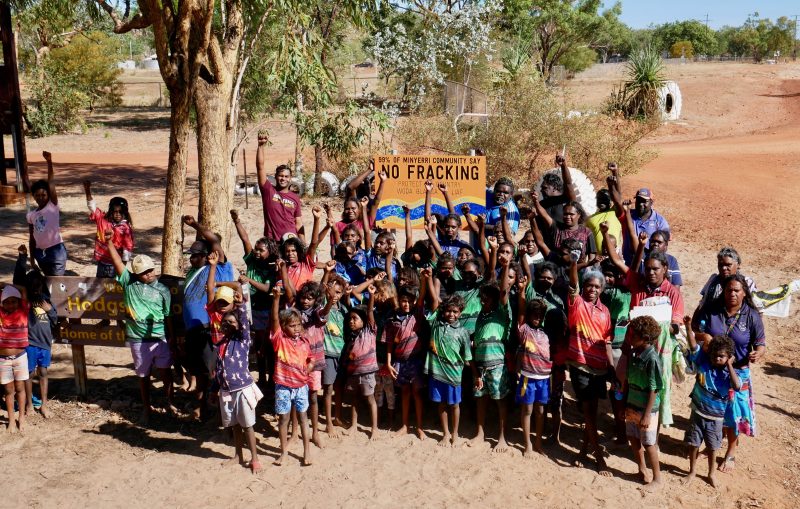Cash-strapped Northern Territory eyes gas reserves to beat debt
The indigenous Minyerri community, which has a population of a few hundred, fear their water will be contaminated by the fracking (-)
Darwin (Australia) (AFP) – Australia’s Northern Territory is trying to clear some of its mountainous debts by ending a ban on fracking its vast gas reserves, but green activists and indigenous groups say officials rushed the plan through without addressing key issues.
With debt set to surge past Aus$6 billion next year, quadrupling from just two years ago — and estimated to hit Aus$35 billion in a decade — lawmakers are desperate to find ways to fill the gap.
Having already sold a 99-year lease for Darwin’s port to a Chinese firm with extensive government contacts — causing consternation in Canberra and among Australia’s military allies — attention is now on what sits beneath the sandy ochre earth.
The Beetaloo Basin – a resource-rich area hundreds of kilometres south of Darwin — is believed to hold three-quarters of the Territory’s shale gas resources.
The industry’s speculative forecasts suggest the Territory may have up to 500 trillion cubic feet of gas reserves — more than the United States’ proven reserves — with the potential to bring in vast royalties.
“Estimates have predicted that hundreds of millions of dollars could be spent on civil works and gas exploration in the Territory this year,” the state’s Natural Resources Minister Paul Kirby told AFP.
“I am focused on making sure the emerging onshore gas industry focuses on local employment and local business opportunities.”
– ‘Farcical’ decision –
A moratorium on fracking in the region was put in place in 2016 over public opposition to the practice and to allow an independent commission of inquiry to be established.
But last month the centre-left government lifted the embargo, with Environment Minister Eva Lawler saying it understood the importance of protecting the environment and will eventually implement all 135 fracking recommendations made by the inquiry last year, though she offered no firm time frame.
“The Territory’s natural environment is one of our best assets and a huge part of what makes living here so special,” she said.
“Protecting the environment creates jobs — good environmental policy is smart economic policy.”
In the meantime, it has introduced a “code of practice” it says will keep the onshore gas industry “accountable and transparent”.
Australian Petroleum Production and Exploration Association spokesman Matt Doman said the guidelines “represent some of the most comprehensive and rigorous regulations in the world”.
“They set enforceable standards for a range of activities, including well operations, surface activities, and water management. After almost three years of activity lost to the moratorium and its resolution, the industry hopes to start exploration as soon as possible.”
But Graeme Sawyer, a spokesman for the Protect Country Alliance called the government’s green light “farcical”.
“The NT Government has a long history of being incompetent at these sorts of things,” he said. “They can’t get their processes in government working and get their facts straight half the time. They’re cutting corners, and I don’t think they can properly regulate the industry.”
– Contamination fear –
Activists point out that recommended long-term water base testing and biodiversity studies have not yet been completed and that environmental oversight is done by the Department of Energy and Natural Resources, raising questions about conflicts of interest.
While the nominal start date of July 1 has already passed, the government has yet to finalise a list of “no-go zones” — ecological and culturally sensitive areas where fracking would be prohibited.
Its proposal to open 51 percent of the Territory’s 1.4-million-square-kilometre (540,000-square-mile) land mass has been met with fury by environmental groups and remote Indigenous communities, who say they had no say over the designations.
Even before drilling begins, remote cattle station owners are filing lawsuits over the lack of land access agreements.
The small, indigenous community of Minyerri, about five hours south of Darwin with a population of a few hundred, did not make the protected list because it lies within the resource-rich Beetaloo sub-Basin area.
“There was zero community consultation from the government, and the people of Minyerri were upset about decisions made in Darwin that affect their land and culture,” said Vanessa Farrelly, an indigenous organiser with the Seed Indigenous Youth Climate Network.
“A lot of people living in Minyerri are traditional owners of Alawa country. They’re afraid their water will be contaminated.”
The final no-go zones are expected to be finalised in the coming months.
Disclaimer: Validity of the above story is for 7 Days from original date of publishing. Source: AFP.


